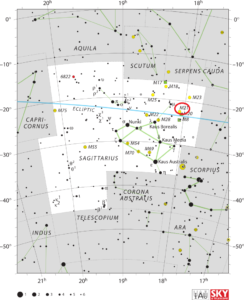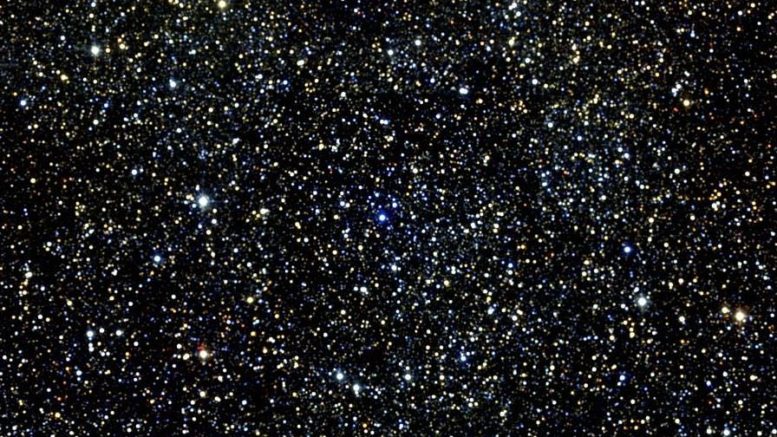Messier 21 is an open cluster that consists mainly of small, faint stars, but is also home to a few blue giants. The cluster contains about 57 confirmed members, but is pretty densely packed. It is classified as of Trumpler class I 3 r, which means that is a detached cluster with strong central concentation (I), consists of both bright and faint stars (3), and contains more than 100 stars (r).
| Description | |
| Visible From Pacific Northwest | June, July and August |
| Best Time To Observe | June, July and August |
| Minimum Size Of Viewing Device | Binoculars |
| Object Type | Open Cluster |
| Designations | Messier 21, M21, NGC 6531, OCl 26.0, MWSC 2796, GC 372, C 1801-225 |
| Right Ascension | 18h 04.6m |
| Declination | -22°30′ |
| Constellation | Sagittarius |
| Number Of Stars | 57 |
| Apparent magnitude | +6.5 |
| Apparent dimensions | 13′ |
| Object Radius | 8 light years |
| Distance From Earth | 4,250 light years |
History
Charles Messier discovered this object on June 5th, 1764. As he wrote in his notes on the occassion:
“In the same night I have determined the position of two clusters of stars which are close to each other, a bit above the Ecliptic, between the bow of Sagittarius and the right foot of Ophiuchus: the known star closest to these two clusters is the 11th of the constellation Sagittarius, of seventh magnitude, after the catalog of Flamsteed: the stars of these clusters are, from the eighth to the ninth magnitude, environed with nebulosities. I have determined their positions. The right ascension of the first cluster, 267d 4′ 5″, its declination 22d 59′ 10″ south. The right ascension of the second, 267d 31′ 35″; its declination, 22d 31′ 25″ south.”
Charles Messier Upon Discovery of M21
Locating M21 In The Sky
Messier 21 lies just beyond naked eye visibility, but can easily be found even in the smallest binoculars. It is located 2.5 degrees northwest of Messier 8, the Lagoon Nebula, and only 0.75 degrees to the northeast of Messier 20, the Trifid Nebula. The cluster can be found using the Teapot asterism, formed by the brightest stars in Sagittarius, to first find either of the two famous nebulae and then use them to locate M21.

Viewing M21
The cluster contains about 35 stars with a visual magnitude between 8 and 12. Many of these stars can easily be seen in a small telescope. 6-inch or larger telescopes will show many more stars tightly packed within an area 13 arc minutes in apparent size.
Photographing M21
Photographing M21 can be a bit of a challenge in regards to which settings to use as they will vary depending on the setup. However, from what can be obtained online, using a DSLR with auto guiding can obtain a great image. Using an f/2.8 or similar focal length with 30 to 300 seconds of exposure per photograph with an ISO of 800, it is indeed possible to capture this
Sources And Further Reading
Descriptions of all of Messier Objects can be found here.
https://freestarcharts.com/messier-21

Leave a comment